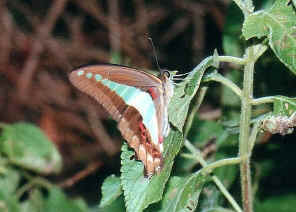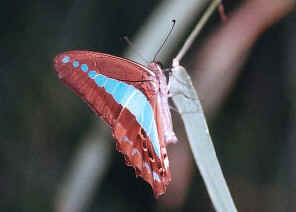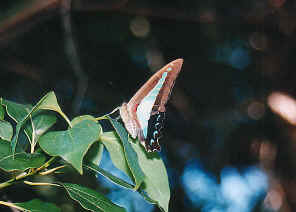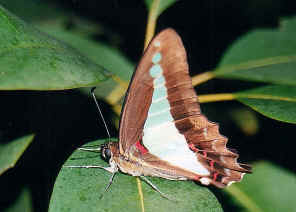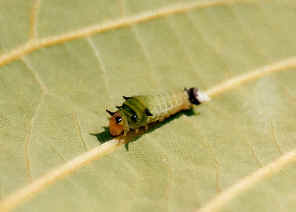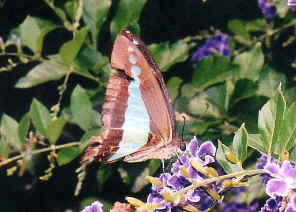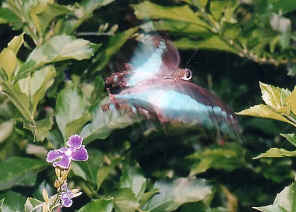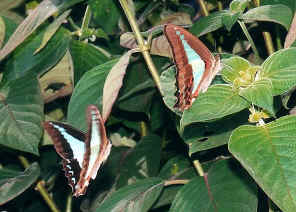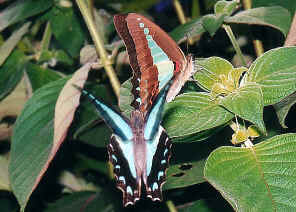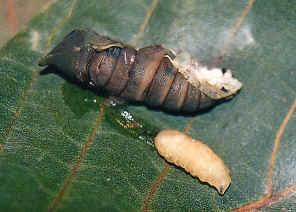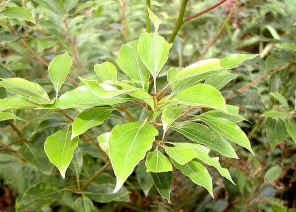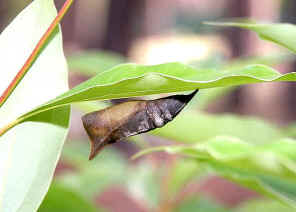|
|
Blue Triangle Butterfly - Graphium sarpedon
FAMILY PAPILIONIDAE
This page contains information and pictures about Blue Triangle Butterflies in the Brisbane area, Queensland, Australia.

- Wingspan : 80mm
The Butterfly
The Blue Triangle Butterflies have wings which are black to dark brown in colour with large blue area in the middle. Those blue patterns joint to make a triangle and this comes their common name. The underside pattern of the wings are similar except there are the red spots on the hind wings bottom.
- Blue Triangle Butterflies are often seen in the bush on a sunny day during summer in Brisbane.
- Above first picture shows a Blue Triangle Butterfly looking for a suitable location to lay her eggs on a native laurel plant.
The Caterpillar
- Caterpillar, early instars length 10mm
- The Blue Triangle caterpillar foodplants are mainly belong to laurel family (Lauraceae) such as camphor laurel Cinnamomum camphora. The early instars stages of the caterpillar usually found feeding on the leaf bottom side, which the small caterpillar has the same colour as the leaf bottom.
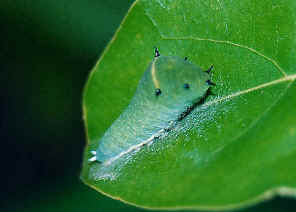
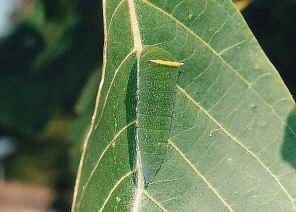
- Caterpillar length 20mm, 40mm
- The later instars stages caterpillar are bright green in colour with a white line near the head, which usually found on the leaf tops side. Their body is tapered from head to tail. When in rest, they make a pad of silk to sit on. When disturbed, the caterpillar display the osmeterium from it head, which is yellow in colour. Together there is the pungent smelling which could usually drives the predator away.
The Pupa
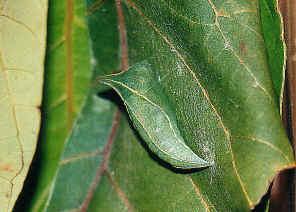
- Pupa length 35mm
- Their pupa are green in colour with veins pattern. They blend very well in the leaf background and hard to be noticed. Like most other swallowtails pupa, Blue Triangle pupa attach on leaf of food plant with head upwards by the creamaster on one end and a central silken girdle on the other end.
Courtshipping
Blue Triangle butterflies fly very fast and are seldom at rest. When they are feeding on flowers, their wings are held vertically and constantly vibrate.
The above pictures shows a pair of Blue Triangle Butterflies courtshipping. The female and male butterflies are looked almost the same. When look carefully, we can see the male bear a fringe of scent-bearing hairs along the inner edges of his hindwings which he uses it to disperse scent to the female.
The Parasitise
We found that Blue Triangle Butterflies are also suffered the parasitise by Tachinid Fly. The about picture shows a fly larvae just emerged from a Blue Triangle pupa. More information about fly parasitise please visit our Tachinid Fly page.
The Host plant
Camphor Laurel is an introduced species and adapted by the Blue Triangle as their host plant. The plant is toxic to humans and considered as serious weed. Camphor Laurel can be found near creek as a dense large tree. The above right picture shows a empty parasited Blue Triangle pupa.
- Link and reference:
- 1. Wild plants of greater Brisbane - Queensland Museum, p343.
